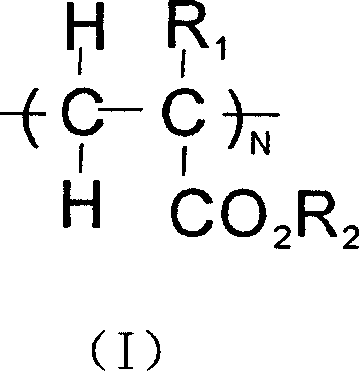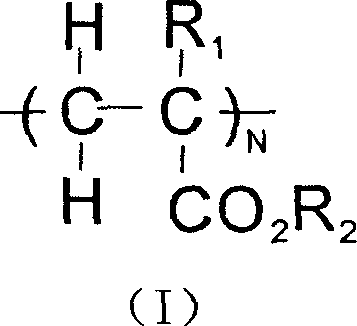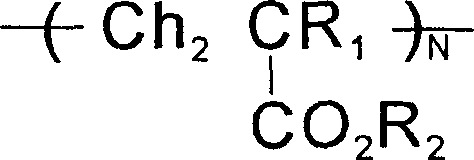Method for preparing nano composite material from waste material and CO2
A nano-composite material, CO2 technology, applied in the field of producing nano-composite materials with waste and CO2, to achieve an environmentally friendly effect
- Summary
- Abstract
- Description
- Claims
- Application Information
AI Technical Summary
Problems solved by technology
Method used
Image
Examples
Embodiment 1
[0048] Example 1: Preparation of thermal insulation, light weight, thick boards and profiles.
[0049] Its steps and process conditions are as follows:
[0050] Step 1: Diffusion and Mixing
[0051] In a 45-liter sealed pressurizer, add 25 kilograms of waste polystyrene plastic (PS) (previously crushed into millimeter segments and granules), add 0.001 kilogram of epoxy silicate, 0.01 kilogram of talcum powder and CO 2 1.5 kg, at room temperature 25°C±2°C, pressurize 6-9MPa, diffuse statically for 2 hours, or stir dynamically for 0.5 hour.
[0052] Step 2: Reaction and pre-expansion.
[0053] The mixed materials mixed in the first step are input into the heating reaction pre-expander, and the temperature is maintained at 90-95°C. The equipment can be installed in a general-purpose cylinder with a diameter of 650-700mm and a height of 1100mm. The production capacity is 35-85 kg / hour. If steam heating is used to control the steam pressure: 0.190Mpa, electric heating can be use...
Embodiment 2
[0065] Example 2: Preparation of interior and exterior wall insulation, radiant heating insulation layer, and color metal plate sandwich layer
[0066] step one:
[0067] 25.5 kg of waste PS, 0.01 kg of epoxy silicate, 0.03 kg of acrylic acid, 1 kg of waste polyethylene or waste polypropylene, 0.01 kg of dicumyl peroxide (DCP), CO 2 Put 2 kg into a 45 liter pressure sealer, pressurize at 6.5-10.0 MPa, stir for 0.3-1 hour, heat up to 120°C for 10 minutes, and cool to room temperature.
[0068] Step two:
[0069] Add the mixture of step 1 to the high-speed mixer, add 0.0-0.4g / 100g liquid paraffin, 0.3-0.5g / 100g citric acid, 0.3-0.5g / 100g sodium hydrogen phosphate, mix for 10 minutes and then input into ordinary extrusion machine. Extrude the insulation layer with a thickness of less than 30mm. The surface can be pasted with ordinary building adhesives on the inner and outer walls of the concrete and the radiant heating insulation layer under the floor. The color steel and col...
Embodiment 3
[0073] Example 3: Preparation of lightweight polymer building materials
[0074] step one:
[0075] After drying the white mud (slag mainly containing kaolin and mica, with a particle size of 80 microns to 20 microns) at 60°C, weigh 25 kg of dry white mud, add 0.01 kg of epoxy silicate, 0.02 kg of acrylic acid, silicon Sodium acid (Na2SiO3) 1.00 kg, sodium hydroxide 1.0 kg, water (neutral) 0.5 kg, CO 2 Add 12.5 kg into a 45-liter pressure sealer, pressurize at 6.5-10 MPa, stir for half an hour, heat up to 40-90°C for 10 minutes, and cool to room temperature.
[0076] Step two:
[0077] Pour the mixture in step 1 into the prefabricated molds such as boards, walls, special shapes, etc., which can be used as hollow outer walls, solid inner columns, board core materials, etc.
[0078] Step three:
[0079] Add the mixture of step 1 in example 1 to the hollow outer wall or inner column of step 2 in this example, and use the suction input method to keep the gaps in the irregular ...
PUM
| Property | Measurement | Unit |
|---|---|---|
| aspect ratio | aaaaa | aaaaa |
| tensile strength | aaaaa | aaaaa |
| tensile strength | aaaaa | aaaaa |
Abstract
Description
Claims
Application Information
 Login to View More
Login to View More - R&D
- Intellectual Property
- Life Sciences
- Materials
- Tech Scout
- Unparalleled Data Quality
- Higher Quality Content
- 60% Fewer Hallucinations
Browse by: Latest US Patents, China's latest patents, Technical Efficacy Thesaurus, Application Domain, Technology Topic, Popular Technical Reports.
© 2025 PatSnap. All rights reserved.Legal|Privacy policy|Modern Slavery Act Transparency Statement|Sitemap|About US| Contact US: help@patsnap.com



